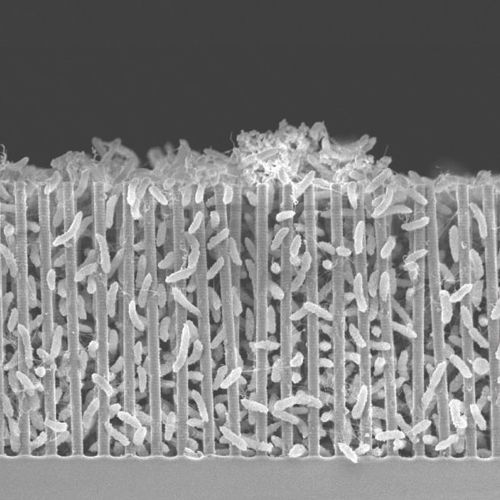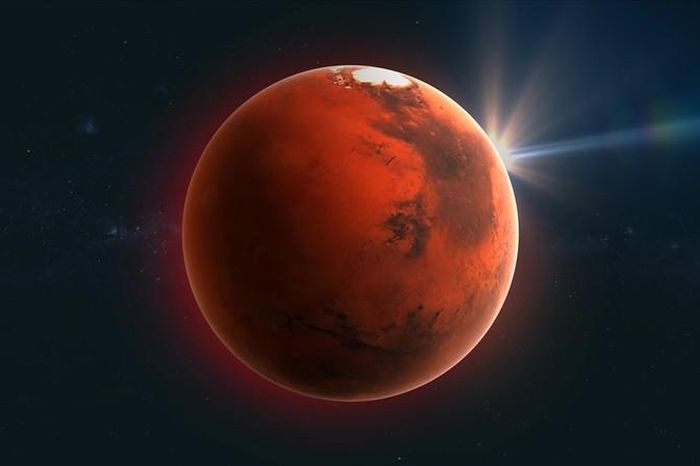This is how humans can build life from nothing on Mars
The device is a collection of bacteria attached to a nanowire frame. The researchers say it could be the key to helping us produce a range of important medicinal materials and many more in future colonization on Mars.
In the Earth's atmosphere, carbon dioxide is very small in proportion, so its effects on life and the ecosystem are minimal. But the atmosphere of Mars is almost the opposite, with a carbon dioxide rate of up to 96% instead of just about 1% on Earth. To survive on Mars, the best way a human can do is to make the most of this abundant source of gas.
On Earth, plants live on sunlight. The most efficient plant on our planet, according to the researchers, is sugarcane, which converts up to 5% of sunlight and carbon dioxide into sugar. The structure of the aforementioned nano power plant is a two-part system that mimics the life mechanisms of true plants. A framework made of nanowires will attract electrons to feed the important bacteria mounted on them, and these bacteria will convert electrons into acetate molecules.
Acetate is a fairly common substance in consumer resins, but that is only a tiny fraction of the surface of the acetate iceberg. In its simplest chemical form, acetate, or acetic acid, is vinegar. Acetate molecules play a vital role in making many components of life through biosynthesis. Molecules in the body, like amino acids and cholesterol, are biosynthesized.

The nano power plant was created by scientists at the University of California
" Acetate molecules can act as bricks to form a series of organic molecules, from fuels and plastics to medicines, " the scientists said. " Many other organic products can be made from acetate inside genetically modified organisms, such as bacteria or yeast ."
Chemical professor and lead researcher, Peidong Yang, says his team is working on similar systems that can produce " sugars and carbohydrates " - also an active bio-hybrid system. based on the mechanisms of plant life.
The idea of living on Mars is still a long way off, but the University of California team hopes its nanoscale nanoscale framework could be used to reduce pollution on Earth. On Mars, carbon dioxide is the only reasonable choice to make abundant natural fuel. On Earth, capturing carbon dioxide from the air and turning it into energy can make a big difference to the environment. It is also a very far-reaching goal, but at least the possibility of successful implementation on Earth is still much higher.
And in the long run, this NASA-funded research could really make a big difference. " For a distant space mission, you need to pay attention to the issue of cargo volume, " Yang said. " Biological systems have the advantage of being self-produced: you don't have to carry them around too much. That's why our bio-hybrid version is so exciting ."
You should read it
- The strangest objects ever taken on Mars surprised many
- 5 most interesting findings about Red Planet
- Stunned to discover river fossils on Mars
- There are major changes in the atmosphere of Mars
- Find strong evidence of life on Mars
- Why are microorganisms living 'so tough' on Earth but still hard to survive on Mars
- The answer to the disappearance of water on Mars already exists
- Details of the plan to turn a successful Mars man for only $ 100,000 by Elon Musk
May be interested
- Reveal the best place to find life on Mars
 nasa's spirit self-propelled robot has found evidence of life on mars before being trapped in a sand pit and confirmed to disappear by nasa in 2010? it can be said that two geographers have identified a position on earth formed by microorganisms that closely resemble a specific area of mars observed carefully by self-propelled robots in 2007.
nasa's spirit self-propelled robot has found evidence of life on mars before being trapped in a sand pit and confirmed to disappear by nasa in 2010? it can be said that two geographers have identified a position on earth formed by microorganisms that closely resemble a specific area of mars observed carefully by self-propelled robots in 2007. - How does human body change in Mars?
 after settling down in mars, completely isolated, the different and harsh natural environment can become a completely new type of person.
after settling down in mars, completely isolated, the different and harsh natural environment can become a completely new type of person. - Looking back at NASA's Mars exploration process over the past 20 years
 the following article will help you have a better overview of the journey to explore mars since the first time nasa brought robots to mars, two decades ago.
the following article will help you have a better overview of the journey to explore mars since the first time nasa brought robots to mars, two decades ago. - How will the world change in the next 1000 years?
 can humans survive on earth for another 1,000 years? if that happens, what will people look like?
can humans survive on earth for another 1,000 years? if that happens, what will people look like? - The strangest objects ever taken on Mars surprised many
 scientists have captured many strange things on mars, from spoons, squirrels, blueberries to women ... but no one is sure whether they are real or not.
scientists have captured many strange things on mars, from spoons, squirrels, blueberries to women ... but no one is sure whether they are real or not. - 5 most interesting findings about Red Planet
 mars has always attracted the attention of scientists. people have sent a lot of probes to discover interesting things in this red planet. the findings below will certainly surprise you.
mars has always attracted the attention of scientists. people have sent a lot of probes to discover interesting things in this red planet. the findings below will certainly surprise you. - 'Mars Garden - Martian Gardens' helps scientists find ways to grow vegetables on Mars
 simulation of martian gardens helps nasa scientists learn about plants that astronauts can grow on red planet.
simulation of martian gardens helps nasa scientists learn about plants that astronauts can grow on red planet. - The microbiome in desert lagoons may reflect early life on Mars
 microbiota in lagoons in the puna de atacama desert, argentina, may reveal early life on earth and mars.
microbiota in lagoons in the puna de atacama desert, argentina, may reveal early life on earth and mars. - Organic matter on Mars was not created by life?
 newly published research shows that a large amount of organic matter on mars was not created by life, but by natural processes.
newly published research shows that a large amount of organic matter on mars was not created by life, but by natural processes. - 5 Do NOT let life become happy without any problems
 we humans are so strange that everyone wants to enjoy the long and happy life, serenity for the whole life, but always engrossed in fighting, resentment against each other. if only each of us knew how to control our instincts, knowing to stop at the right time, then surely this life would not be sad, how beautiful it would be.
we humans are so strange that everyone wants to enjoy the long and happy life, serenity for the whole life, but always engrossed in fighting, resentment against each other. if only each of us knew how to control our instincts, knowing to stop at the right time, then surely this life would not be sad, how beautiful it would be.










 Theoretically, hairless moles can be immortal
Theoretically, hairless moles can be immortal SpaceX's first plan to put people in space will officially take place in May
SpaceX's first plan to put people in space will officially take place in May Indonesian volcano erupted, creating a column of smoke as high as nearly 200 meters
Indonesian volcano erupted, creating a column of smoke as high as nearly 200 meters Scientists created a mutant enzyme that 'ate' nearly a ton of plastic bottles after a few hours
Scientists created a mutant enzyme that 'ate' nearly a ton of plastic bottles after a few hours Experimental science proves that gravity is still effective at 50 micrometers
Experimental science proves that gravity is still effective at 50 micrometers Find out the mechanism of producing solar cells by enzyme of papaya
Find out the mechanism of producing solar cells by enzyme of papaya